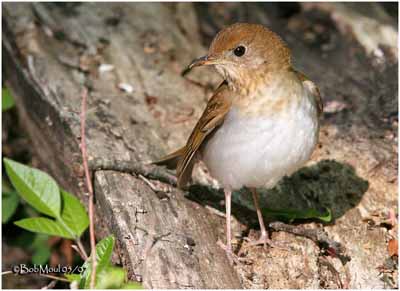
Veery
Catharus fuscescens
Passeriforme Order – Turdidae Family
BIOMETRICS:
Length: 17-19 cm
Wingspan: 28-29 cm
Weight: 28-54 g
LONGIVITY: Up to 10 years
DESCRIPTION:
Veery has reddish-brown upperparts and white underparts, flanks are grey, face is greyish, with incomplete and indistinct grey eyering. Sides of throat and breast are buff, with indistinct fine brown spots. Centre of throat and belly are white.
Veery has pale bill and legs. Bill has black upper mandible and creamy pink lower mandible, with black tip. Legs and feet are creamy pink. Both sexes are alike.
PROTECTION / THREATS / STATUS:
It seems that populations may be in decline in recent decades. Increased access to nest for Brown-headed Cowbirds has increased parasitism, due to forest fragmentation, and more edge habitat favourable for Cowbirds.
Fr: Grive fauve
All : Wilson-Drossel
Esp : Tordo Cachetón
Ital : Tordo usignolo bruno
Nd : Veery
Sd : Rostskogstrast
Photographs by Bob Moul
His website :
Nature Photography
Photographs by René Lortie
His website : http://rlortie.ca/
Text by Nicole Bouglouan
Sources:
HANDBOOK OF THE BIRDS OF THE WORLD Vol 10 by Josep del Hoyo-Andrew Elliott-David Christie - Lynx Edicions - ISBN: 8487334725
FIELD GUIDE TO THE BIRDS OF NORTH AMERICA - National Geographic Society - ISBN: 0792274512
A GUIDE TO THE BIRDS OF MEXICO AND NORTHERN CENTRAL AMERICA by Steve N. G. Howell, Sophie Webb - Oxford University Press - ISBN: 0198540124
All About Birds (Cornell Lab of Ornithology)
Wikipedia (Wikipedia, The Free Encyclopedia)
Bird Web (Seattle Audubon Society)
Birds of Nova Scotia (Robie Tufts)
What Bird-The ultimate Bird Guide (Mitchell Waite)

VOICE: SOUNDS BY XENO-CANTO
Veery’s typical call is a low “phew”, often prolonged and slurred ‘veer”. Song is a rolling, descending series of notes “da-vee-ur-vee-ur-veer veer”. Each note gets progressively lower in pitch, creating the sensation of spiralling or cascading down the scale. Veery’s song has a very good quality that makes it unique.
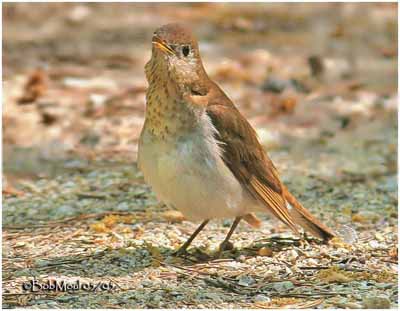
HABITAT:
In natural range, Veery favours undergrowth in deciduous and mixed woodlands (less often coniferous forest) especially near streams, where the land is damp and boggy.
RANGE:
Veery breeds from southern British Columbia, southern Quebec and south-western Newfoundland, south to Oregon, Ohio and New Jersey, and in the mountains to Georgia. It winters in South America.
BEHAVIOUR:
When on the ground, Veery tends to cock tail higher. It is easy to see it hopping along the forest floor as they search for insects and other preys. It forages low in the vegetation or along the ground. Sometimes, it pokes at decaying logs, and flips over leaves and stones, in search of insects.
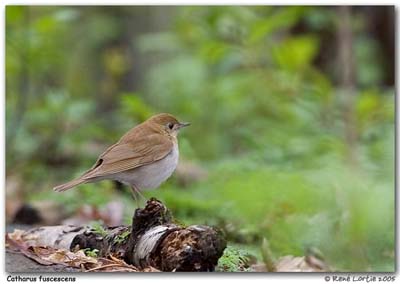
It also can hover while picking insects from foliage, and occasionally flies out from a perch to snag a flying insect in mid air.
The male chooses a nesting site which it defends from other males. It attracts females by singing. Veery is monogamous. One brood is raised, possibly two in the southern of its range.
Veery’s courtship display is simple. Bird draws head back, bill up at 45 degrees and slightly to side, may also flicks wings and raises crest. The male pursues the female in flight around its territory. Female may sing a duet with the male. The entire process lasts 3 to 4 days.
In conflict situation, the bird hold its body in an erect posture, also may flicks its wings and tail. In high conflict between two males fighting over a territory, males will raise their bills and then, snap them forward at one another.
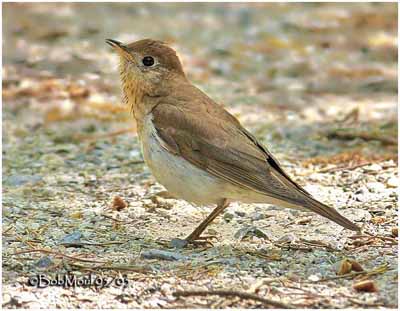
FLIGHT:
Veery migrates at night, the flock keeping together in dark skies communicating with contact calls characteristics of the species. Veery can fly up to 160 miles in one night, and above 1, 2 miles.
REPRODUCTION:
Veery female builds a nest either on the ground or low to the ground, at the base of a shrub or sapling, less than 5 feet high. The nest is an open cup, built on a foundation of dead leaves. It’s built from weeds, twigs, grapevine bark, and wet, mud-like leaf mould, lined with fine rootlets and fibres. Nest is built in 6 to 10 days.
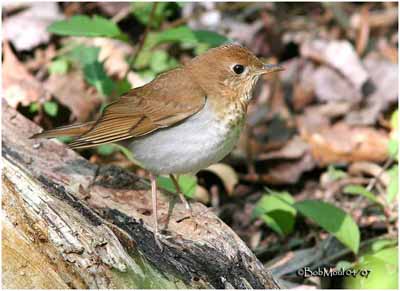
Female lays 4 pale greenish blue eggs. Incubation lasts about 10 to 12 days by female. She broods the young. The male gathers food, witch it passes to the female who feeds the young. They grow quickly, and leave the nest 10 to 12 days after hatching.
DIET:
Berries and insects make up the majority of the Veery’s diet. Insects are the primary food source during the breeding season. In late summer and fall, they feed on berries, and they move higher to forage. Young fed insects. Veery eats beetles, caterpillars, spiders, snails, ants and wasps.
